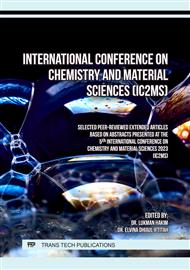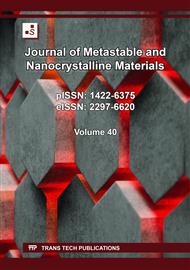[1]
B. Gomathi Thanga Keerthana, T. Solaiyammal, S. Muniyappan, and P. Murugakoothan, "Hydrothermal synthesis and characterization of TiO2 nanostructures prepared using different solvents," Mater. Lett., vol. 220, p.20–23, 2018.
DOI: 10.1016/j.matlet.2018.02.119
Google Scholar
[2]
H. Abdelouahab Reddam, R. Elmail, S. C. Lloria, G. Monrós Tomás, Z. A. Reddam, and F. Coloma-Pascual, "Synthesis of Fe, Mn and Cu modified TiO2 photocatalysts for photodegradation of Orange II," Bol. la Soc. Esp. Ceram. y Vidr., vol. 59, no. 4, p.138–148, 2020.
DOI: 10.1016/j.bsecv.2019.09.005
Google Scholar
[3]
P. Van Viet, B. T. Phan, L. Van Hieu, and C. M. Thi, "The effect of acid treatment and reactive temperature on the formation of TiO2 nanotubes," J. Nanosci. Nanotechnol., vol. 15, no. 7, p.5202–5206, 2015.
DOI: 10.1166/jnn.2015.10025
Google Scholar
[4]
N. Liu, X. Chen, J. Zhang, and J. W. Schwank, "A review on TiO2-based nanotubes synthesized via hydrothermal method: Formation mechanism, structure modification, and photocatalytic applications," Catal. Today, vol. 225, p.34–51, 2014.
DOI: 10.1016/j.cattod.2013.10.090
Google Scholar
[5]
F. Sallem, R. Chassagnon, A. Megriche, M. El Maaoui, and N. Millot, "Effect of mechanical stirring and temperature on dynamic hydrothermal synthesis of titanate nanotubes," J. Alloys Compd., vol. 722, p.785–796, 2017.
DOI: 10.1016/j.jallcom.2017.06.172
Google Scholar
[6]
A. D. Rosanti, A. R. K. Wardani, and H. A. Anggraeni, "Pengaruh Suhu Kalsinasi terhadap Karakteristik dan Aktivitas Fotokatalis N/TiO2 pada Penjernihan Limbah Batik Tenun Ikat Kediri," Indones. E-Journal Appl. Chem., vol. 8, no. 1, p.26–33, 2020, https://jurnal.harianregional.com/index.php/cakra/article/view/62801.
DOI: 10.20473/jkr.v5i1.18169
Google Scholar
[7]
H. Chen, D. Chen, L. Bai, and K. Shu, "Hydrothermal synthesis and electrochemical properties of TiO2 nanotubes as an anode material for lithium ion batteries," Int. J. Electrochem. Sci., vol. 13, no. 2, p.2118–2125, 2018.
DOI: 10.20964/2018.02.75
Google Scholar
[8]
A. Castro-Beltrán et al., "Titanium butoxide molar ratio effect in the TiO2 nanoparticles size and methylene blue degradation," Optik (Stuttg)., vol. 157, p.890–894, 2018.
DOI: 10.1016/j.ijleo.2017.11.185
Google Scholar
[9]
M. H. Razali, M. N. Ahmad-Fauzi, A. R. Mohamed, and S. Sreekantan, "Physicalproperties study of Tio2 nanoparticle synthesis via hydrothermal method using TiO2 microparticles as precursor," Adv. Mater. Res., vol. 772, p.365–370, 2013.
DOI: 10.4028/www.scientific.net/AMR.772.365
Google Scholar
[10]
R. Nagarajan, "Nanoparticles: Building blocks for nanotechnology," ACS Symp. Ser., vol. 996, p.2–14, 2008.
DOI: 10.1021/bk-2008-0996.ch001
Google Scholar
[11]
A. Gaber, M. A. Abdel- Rahim, A. Y. Abdel-Latief, and M. N. Abdel-Salam, "Influence of calcination temperature on the structure and porosity of nanocrystalline SnO2 synthesized by a conventional precipitation method," Int. J. Electrochem. Sci., vol. 9, no. 1, p.81–95, 2014.
DOI: 10.1016/s1452-3981(23)07699-x
Google Scholar
[12]
H. Liu, G. Liu, and Q. Zhou, "Preparation and characterization of Zr doped TiO2 nanotube arrays on the titanium sheet and their enhanced photocatalytic activity," J. Solid State Chem., vol. 182, no. 12, p.3238–3242, 2009.
DOI: 10.1016/j.jssc.2009.09.016
Google Scholar
[13]
C. K. Lee, C. C. Wang, M. Du Lyu, L. C. Juang, S. S. Liu, and S. H. Hung, "Effects of sodium content and calcination temperature on the morphology, structure and photocatalytic activity of nanotubular titanates," J. Colloid Interface Sci., vol. 316, no. 2, p.562–569, 2007.
DOI: 10.1016/j.jcis.2007.08.008
Google Scholar
[14]
J. Huang, Y. Cao, Z. Deng, and H. Tong, "Formation of titanate nanostructures under different NaOH concentration and their application in wastewater treatment," J. Solid State Chem., vol. 184, no. 3, p.712–719, 2011.
DOI: 10.1016/j.jssc.2011.01.023
Google Scholar
[15]
D. L. Morgan, "Alkaline Hydrothermal Treatment of Titanate," Queensl. Univ. Techology, no. August, p.172, 2010.
Google Scholar



